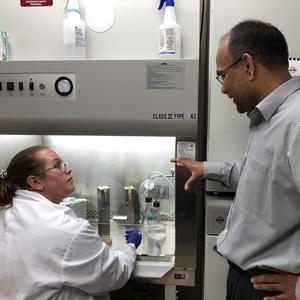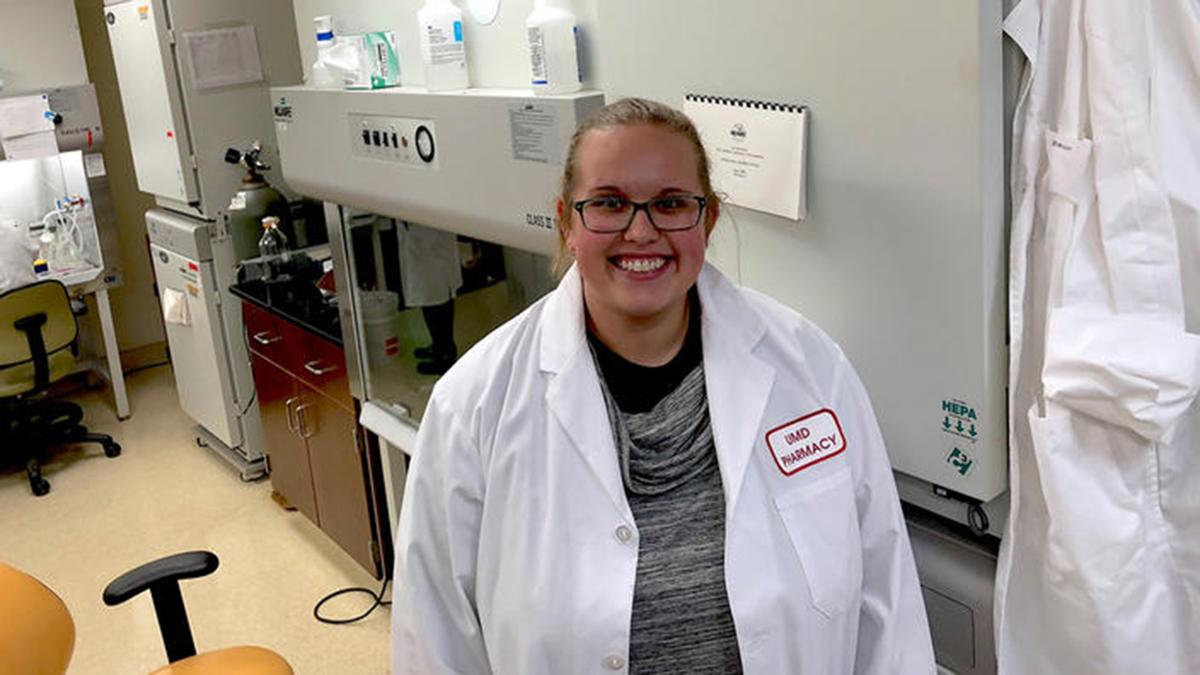The room in the lab is well lit. Kaija puts on her white lab coat, pulls on gloves, and then sanitizes them with alcohol. She opens the incubator, takes out a petri dish and carefully transfers it to the biosafety cabinet. It’s an enclosed, ventilated workspace designed to eliminate cross contamination. She is careful to protect the cells from any harmful microbes that might be in the air.
Several experiments are underway to determine if small molecule drug candidates synthesized by Kaija and other students in Dr. Mereddy's lab affect cancer cells or not. She works mindfully. The life of these cells are in Kaija’s hands.
Cancer Research
When Kaija's first chemical compound went into testing for cancer research, she knew she was in the right place.

“It’s really exciting work,” she says. Kaija is a triple major in biochemistry, chemistry, and women’s studies. In her time at UMD, she has received two Summer Undergraduate Research Project (SURP) awards to work under Dr. Venkatram Mereddy, a professor and cancer researcher.
That means she has the opportunity to formulate chemical compounds and test them to see how cells respond. She says, “The process in Dr. Mereddy’s research lab is fascinating and crucial to cancer research.”
Working through the chemistry department as well as the College of Pharmacy Duluth, Kaija, who is from Belle Plaine, Minn., has also created her own chemical compounds for drug candidates.
She’s got her hands full. She works with Dr. Mereddy year-round and follows the progress of several experiments at once. She is in charge of growing research cells and conducting trials. When the cancer cells seem to shrink in response to the chemical compounds, the work gets extended into progressive stages. She also trains undergrads and graduate students to maintain the fragile cells in the lab.
The Mereddy Laboratory
Erik Brown, UMD’s associate vice chancellor for graduate education and research, says Dr. Mereddy is among UMD's many outstanding faculty researchers. “His lab works to develop novel small molecule anticancer therapeutics, as well as disease-modifying therapeutics that can improve outcomes for neurodegenerative conditions.”
Creating molecules for new drug candidates starts the process. Dr. Mereddy, his students, and his colleagues then conduct trials to test molecules for effectiveness. Their work extends all the way from the petri dish into FDA drug trials. The process is long and few drug candidates make it into drug trials.
Dr. Mereddy holds six patents and has published nearly 80 papers in scientific journals. One of his drug candidates has been licensed by the Office of Technology Commercialization at University of Minnesota to a company for further clinical development. He supervises eight graduate students and four undergraduates. His teaching load is impressive. He has a full course load with three courses in pharmacy. On top of that, he teaches one class in the chemistry and biochemistry department and one as part of the Integrated Bioscience curriculum.
While Dr. Mereddy’s background is in organic chemistry, he works hard to make sure his own students are well rounded. “In today’s scientific world, you have to be ready to look at a dozen approaches to a problem at once,” he says. He makes sure his students have an understanding of molecular biology and biochemistry techniques, as well as a strong foundation in organic chemistry.
The Duluth Connection
Kaija tries to be well-rounded in her life as well. Even with her school and lab schedule, she still manages to find time to volunteer for Program for Aid to Victims of Sexual Assault (PAVSA). “It’s important for me to help out in the community,” she says.
Kaija is currently looking at graduate schools. She says she would love to stay at UMD because of her established work in the labs. She says. “There are some incredible opportunities here. I want to keep pushing myself to do more.”
